11 Brilliant Copywriter Resume Examples + A Guide to Create Yours
There are two things you need to have, or hiring managers won’t even look at your application. Can you guess what they are? Your copywriter resume and portfolio.
Although it’s your copywriting portfolio that truly shows your skills and presents them with your best work, you shouldn’t neglect your CV either. We’ll show you 7 excellent copywriter resumes so you can see how it’s done. Then we’ll take you through the resume writing process step by step.
Copywriter resume examples
If you search for copywriter resume examples, there’s a good chance you’ve found pages upon pages of templates. And even though resume templates can be helpful, real examples give you a better idea of what is expected for your resume.
Ádám Mattyasovszky - Lead Creative / Kraftwork
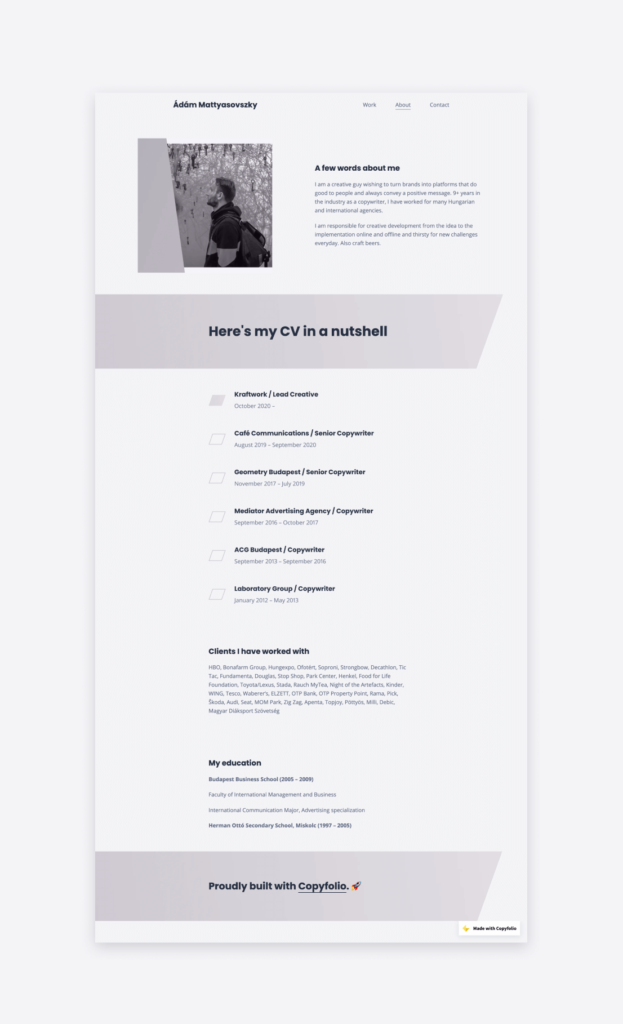
Ádám, who's the lead creative of the advertising agency Kraftwork combined the about page of his portfolio and his copywriter resume. That gave him the space to get started with a short summary of himself, followed by his work history, clients he's worked with, and info about his educational background.
Choosing to make his CV a page on his website, he didn't have to worry about "trying to fit it into one page" as most people do, when they go with the traditional PDF format. He created his portfolio website and resume with Copyfolio.
Karly Nelson - Copywriter / ATI Physical Therapy
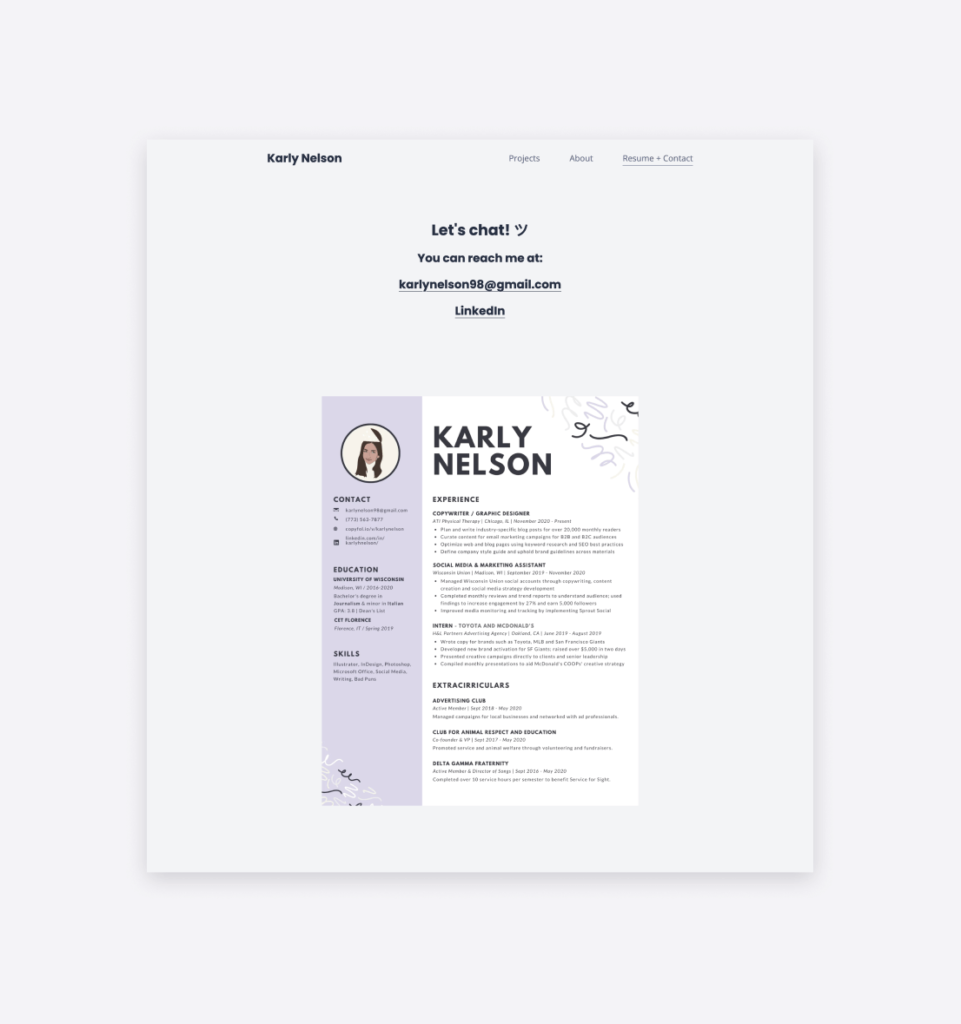
Similar to Ádám, Karly also hosts her resume on her portfolio website. But the difference is that Karly first designed hers as a one-pager, and then added the image of it to her site. It's clearly readable, fun, and totally on-brand, following a more traditional CV structure.
You can find all the important info about her, including her contact information, skills, work experience, education, and even some of her extracurricular activities. Interestingly, she didn't add it to her about page but placed it on her contact page instead.
Karly also created her website with Copyfolio, using the "Letterpress" template.
Katie Rivard - Associate Creative Director / SapientRazorfish
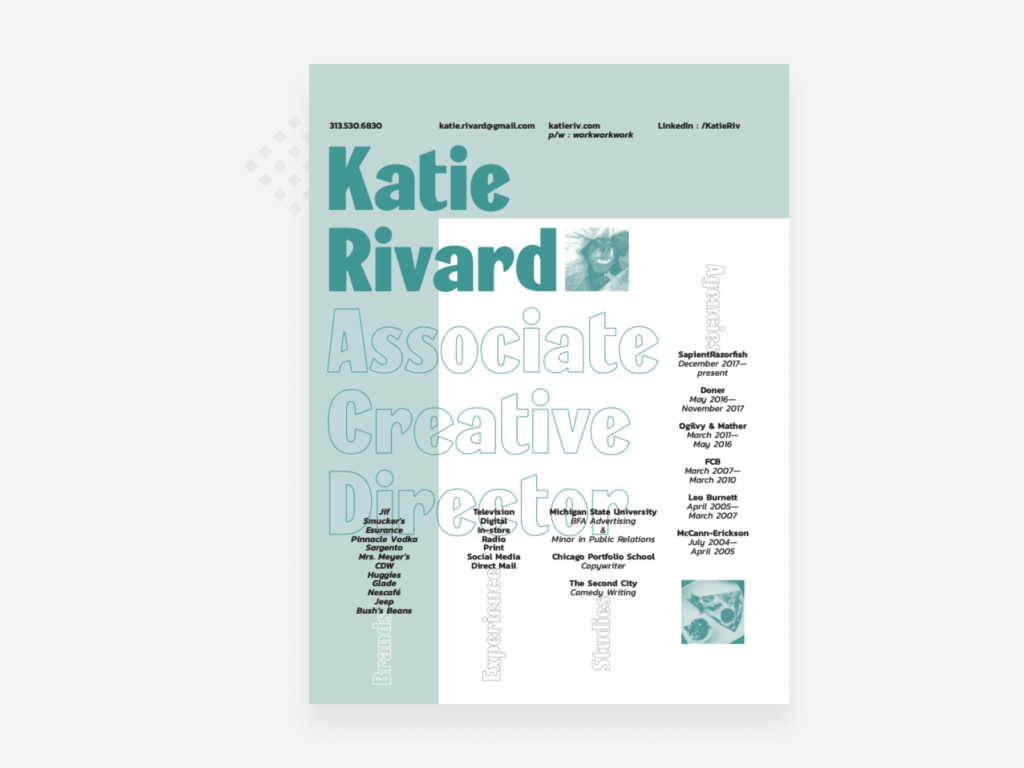
Not your boring CV. That’s the first thought that comes to mind when you see Katie’s copywriter resume. Even though it’s just one page and simple in a way that it lacks descriptions, it has all the information you could possibly need.
In the header, she has her phone number, email address, a link to her portfolio, and her LinkedIn profile link.
Right underneath is her name in big bold letters, followed by her position. All the resume-specific information is organized into four straightforward columns:
- Brands she’s worked with,
- The types of projects she has experience with,
- Her educational background and
- The agencies she’s worked for in reverse chronological order.
Her resume is great, as it stands out from the crowd with its design -and it’s informative, yet concise. You’d be surprised how little time hiring managers spend looking at each resume. So presenting the necessary information in the briefest way possible is crucial.
Graham Bowlin - Senior Copywriter / Cashmere Agency
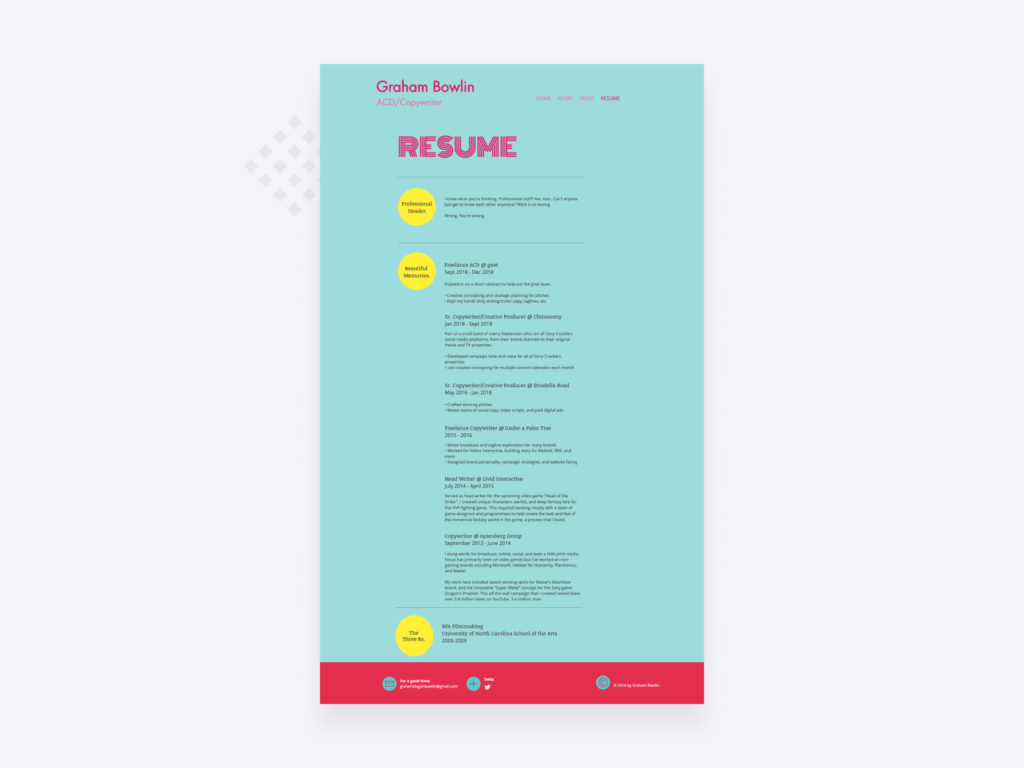
Graham’s copywriter resume is not a stand-alone PDF, but a page hosted on his writing portfolio website. At first glance, the design already grabs your attention –but so does the copy. He starts out with a professional header, immediately showcasing his excellent copywriting skills:
“I know what you're thinking. Professional stuff? Aw, man. Can't anyone just get to know each other anymore? Work is so boring. Wrong. You're wrong.”
Underneath you find two sections: one for his work experience and another for his education. Then right at the bottom, you’ll find his email address and Twitter account, should you want to reach out to him.
Yet again: short and sweet, straightforward but grabs your attention. Exactly what you need for a resume.
Jessica Urgo - ACD, Copywriter / Freelance
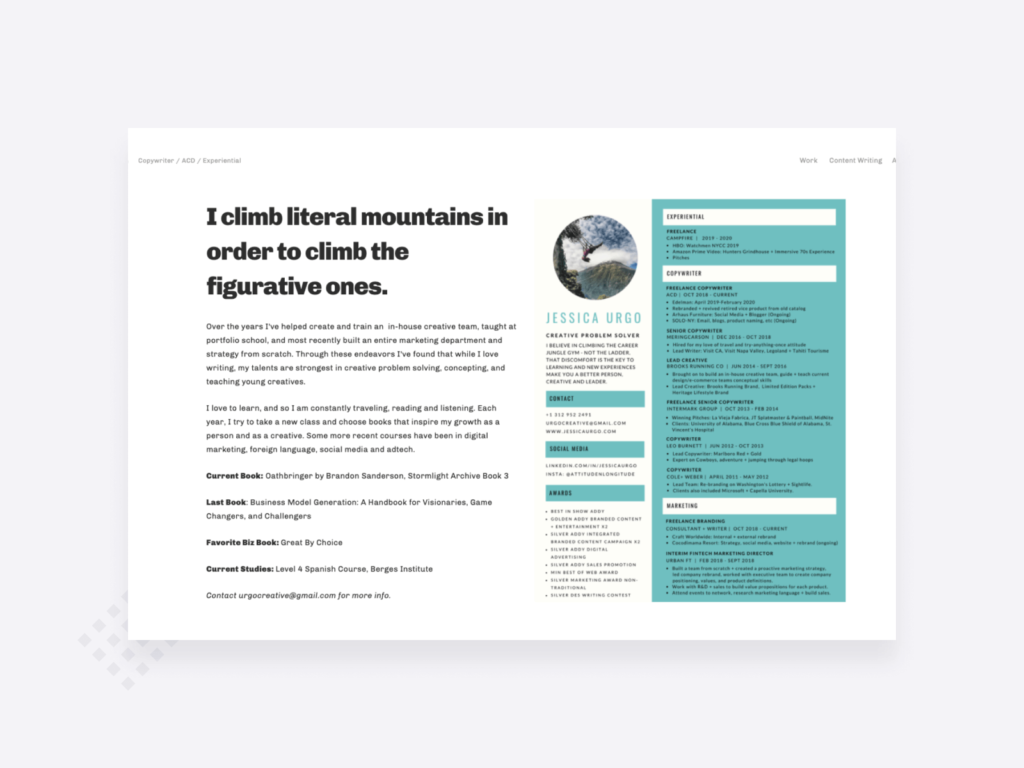
Jessica decided to combine the traditional one-pager PDF format with the “hosting it on my website” approach. On the left, there is a little introduction and facts about her: the books she’s been reading and what she’s studying at the moment.
Then on the right, you have the neatly designed and colorful CV itself. It’s interesting to note that she didn’t include her education and instead decided to focus on her experience, dividing it into three main categories.
Apart from that and her contact information, she features her awards and social media links as well.
Andrew Burke - Senior Copywriter / Bravvura
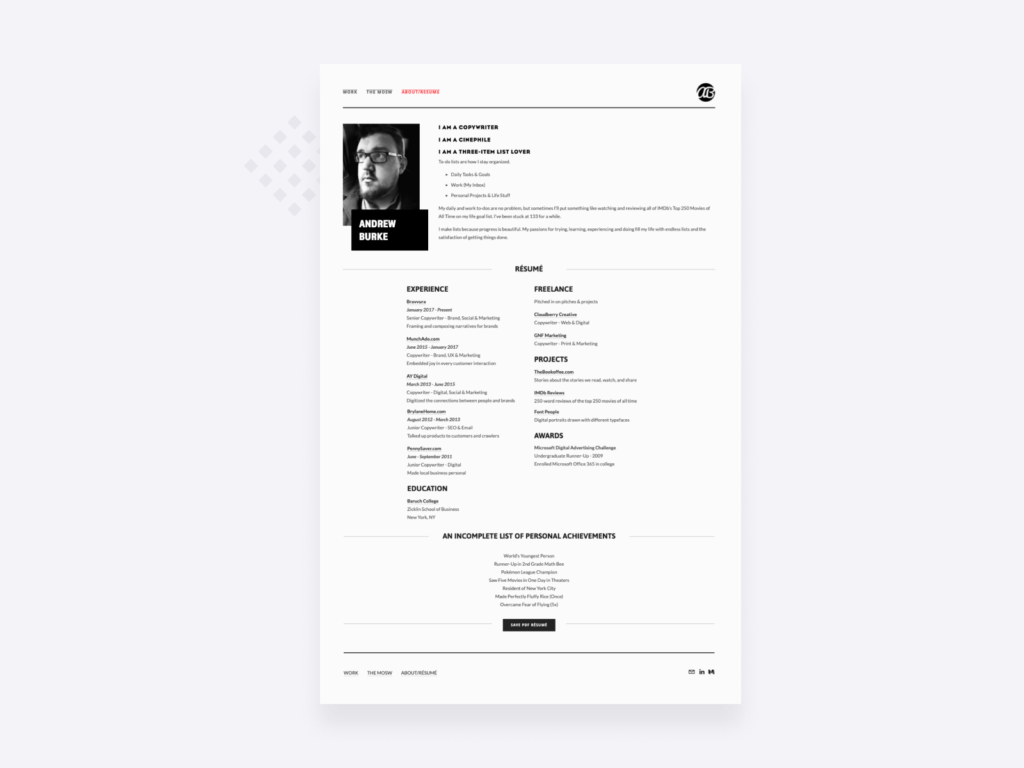
You’d expect a CV to be a little boring, right? Not when it comes to resumes like the one Andrew has. Instead of a single sentence summary, he starts out with a whole section of copy.
You’ll learn that he’s a copywriter, cinephile, and three-item list lover. Then you’ll see a three-item list right underneath that statement. See what he did there? This section is great for showing off his personality and writing skills, warming you up for checking out his CV.
The actual copywriter resume is fairly simple and has the usual sections: experience, education, and awards. Plus, he also added freelance and projects to show his work beyond his full-time positions.
And just to make sure you still won’t get bored, he ends with “an incomplete list of personal achievements” with hilarious items such as being the world’s youngest person.
And in case you’d need it, Andrew gives you an option to download his resume as a PDF at the end.
Stephanie Alkhoury - Creative Copywriter
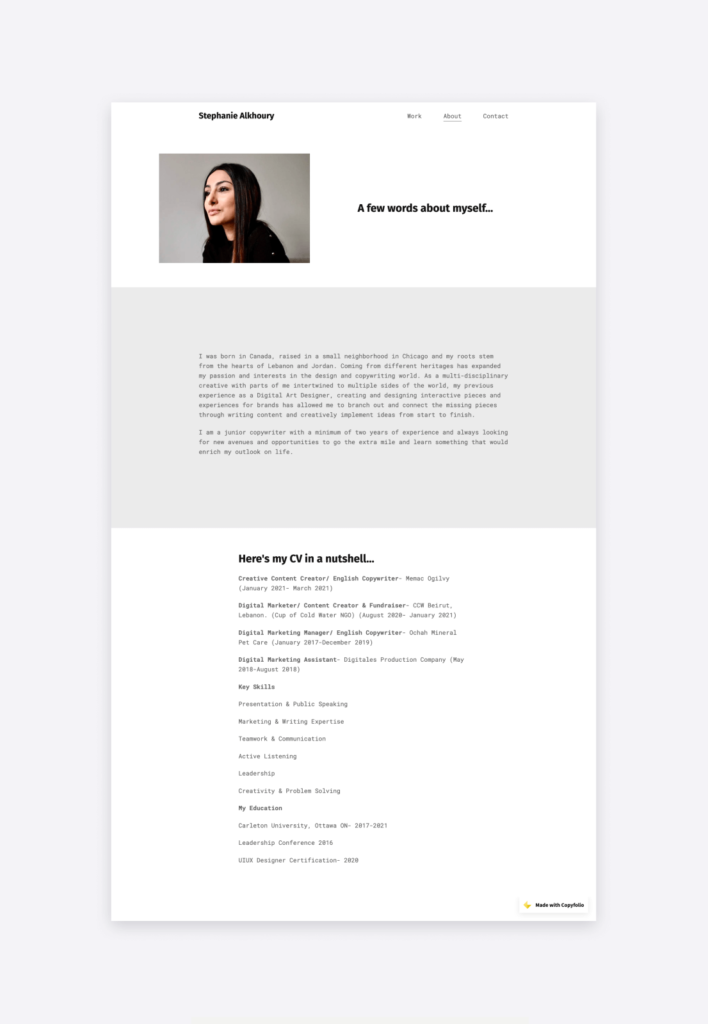
Stephanie created a visually perfectly balanced resume page that gives you the whole picture. You'll see her name and photo, which helps you build a more personal connection. That's followed by a short introduction to her background, and the actual resume itself.
She follows a work experience - skills - education order, leading the reader through the CV in the order she thinks is most important. She created her copywriter resume using Copyfolio.
Dušan Koutský - Senior Copywriter / WMLY&R
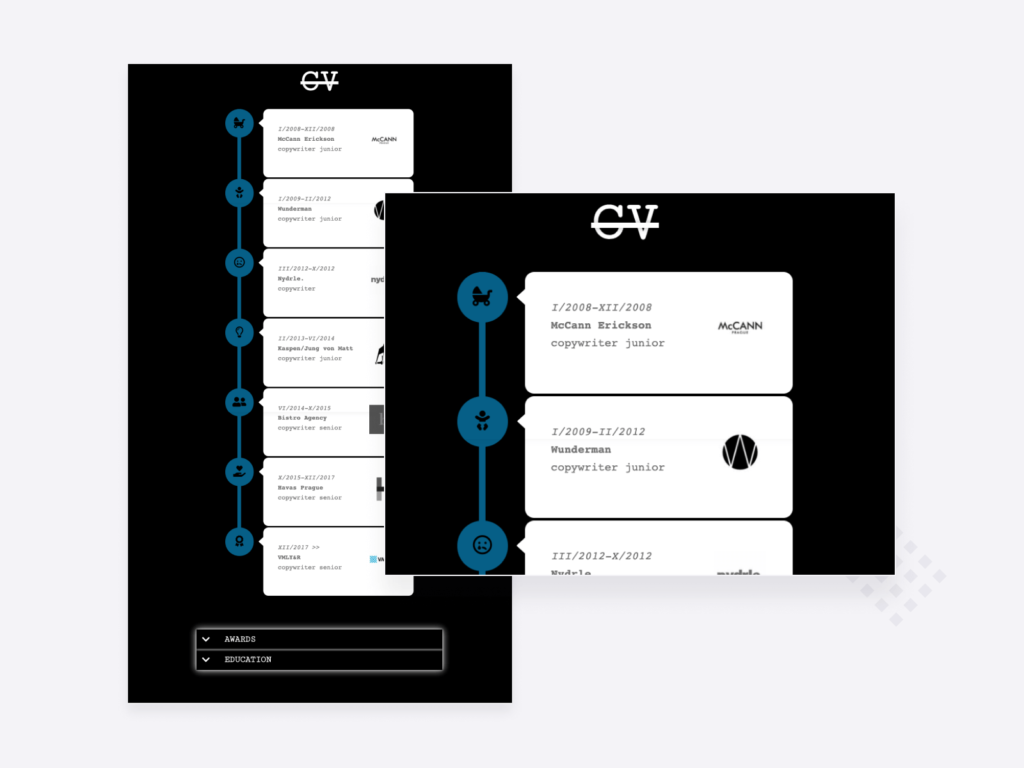
If you want to see a creative copywriter resume, you need to check out what Dušan has done. It’s another website-based resume, made unique by the icons and animations he’s using.
Going against the standard, he lists his experiences in chronological order, marking his first junior position with a stroller, the second with a baby icon. As you scroll down, the animation takes you through these job life stages, right to his current senior copywriter position.
Underneath in sections that you can open up, you can check his awards and education too, if you’re interested.
David Oswald - Creative Director / TBWA\Media Arts Lab
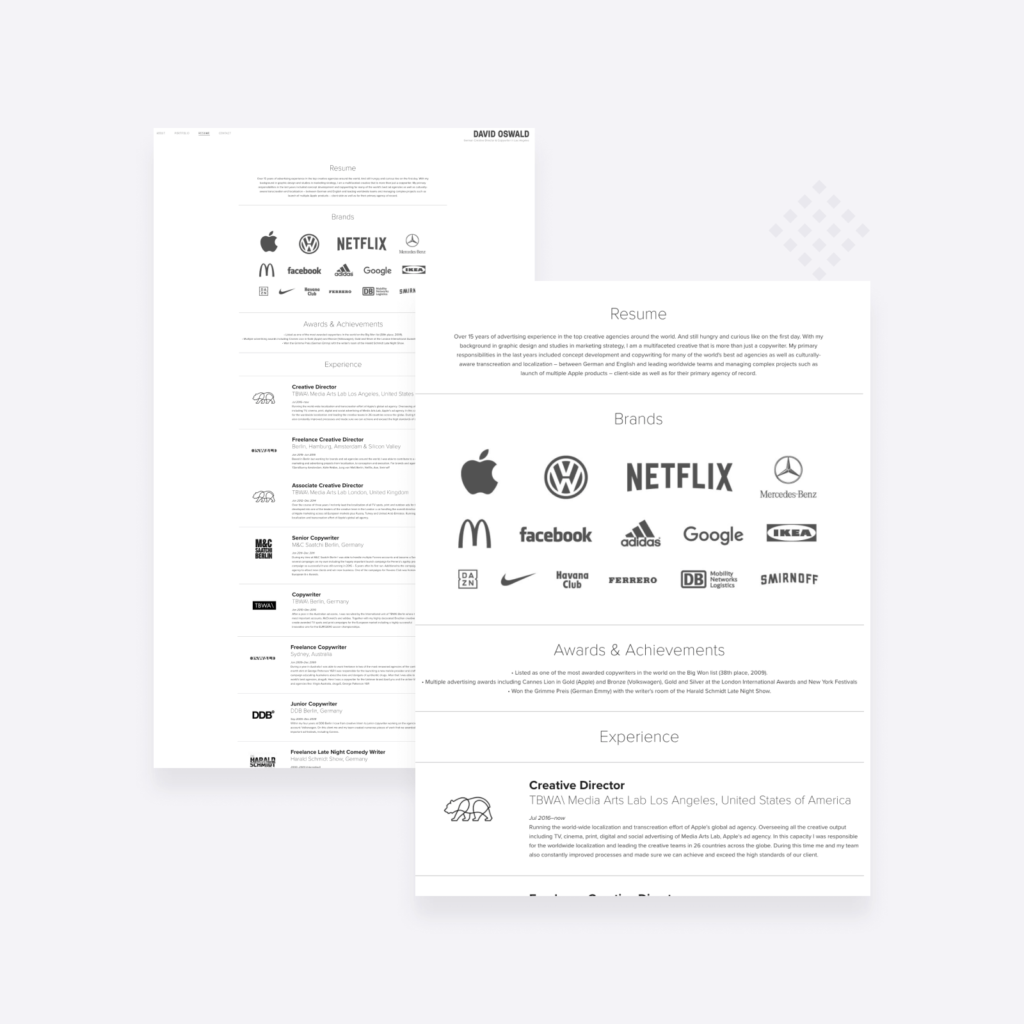
Similarly to Jessica, David also didn’t include education in his CV -and frankly, he doesn’t need to. His awards and experience speak for themselves.
After his short summary, he features the logos of clients he worked with. Impressive in itself, this section includes logos of companies like Apple, Netflix, Facebook, Google, Adidas, Nike, and more.
Next, he goes on to list his awards and only then writes about his work history. The design of his CV is simple, but the structure of the resume leads the viewer nicely and gives a clear overview of David’s experience.
Juliana Paracencio - Global Creative Director / Ogilvy London
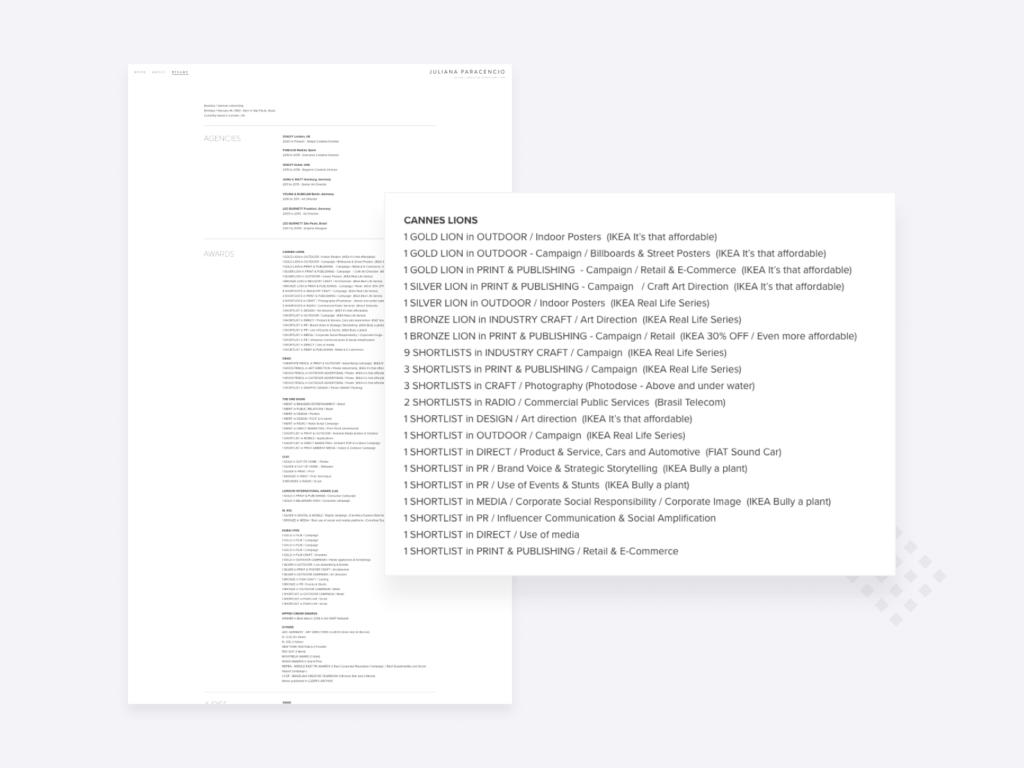
The resume page of Juliana Paracencio is a more typical example of how copywriter resumes usually look. Many copywriters have their CVs as a page on their website, with a very simple text-based, black and white design.
And there’s nothing wrong with that. The only thing you need to pay attention to is the sections. As long as the different sections are separated clearly and there’s enough white space on the page so that the text won’t feel overwhelming… It’s perfect.
Note how Juliana also decided not to list her educational background. With such a long list of awards, including not one but three golden Cannes Lions, there’s not really a need for it anymore, right?
Nicholas Berson - Copywriter / Hylink Digital Solutions
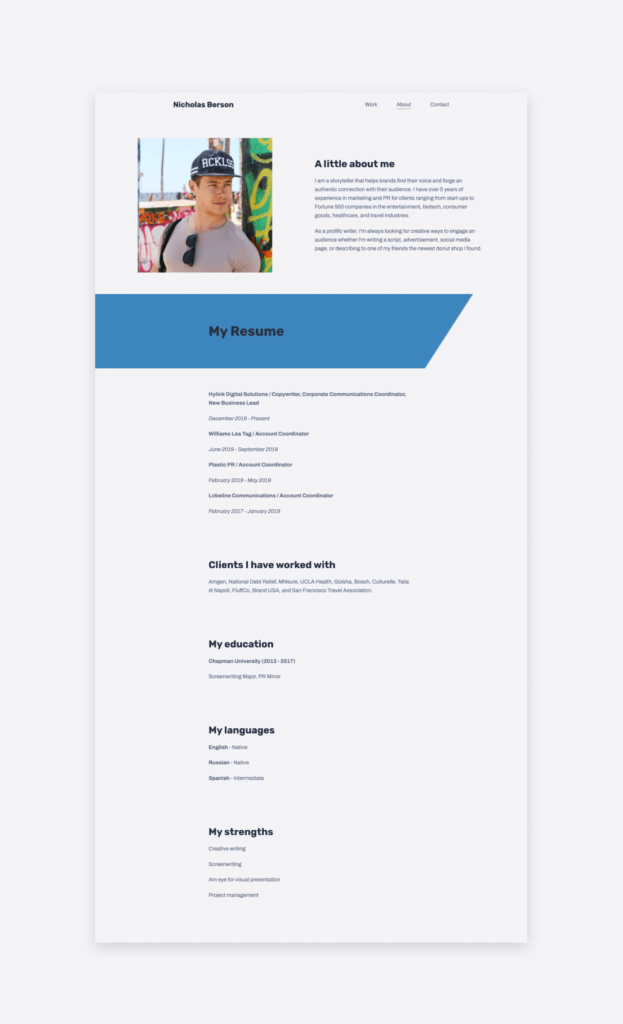
Clear, concise, easy to browse through. That's probably the best way to describe the about page and resume of Nicholas Berson. He uses the formatting and generous white space to draw the eye to each section and outlines his experience and skills with no fluff in-between. And all he used to create it was Copyfolio.
How to write a copywriter resume
Now that you’ve seen some examples and got some inspiration, let’s get into the theory behind. Don’t worry, it’s going to be pretty easy! We’ll outline how to write your copywriter resume in 5 quick steps.
1. Header
The header of your resume is probably what people will look at first. It’s the place for your most important information:
- Your name
- Phone number
- Email address
- LinkedIn page
- And a link to your portfolio.
Your CV and writing portfolio go hand in hand, you cannot have a copywriter resume without a portfolio accompanying it. And as recruiters spend maybe 10 seconds browsing through your resume and 10 minutes checking out your portfolio, make sure the link to it is easily accessible.
After all, your CV only has the hard facts, but it’s your portfolio that will really show off your skills and blow everyone away.
2. Copywriter resume summary or objectives
This section is not absolutely necessary, but still good to have. Originally, this is supposed to be a blurb summarizing your experience or outlining your career objectives: where you’re heading and what your goals are.
What it really is though, is a chance for you to show off your copywriting skills, add a dash of personality, and catch the viewer’s attention.
And as a copywriter, people will expect this part to be really damn good. So if you decide to include it, don’t be afraid to spend more time on it.
3. Work experience
When it comes to listing your previous work experiences, there are three different approaches you can follow, based on whether you’ve been working mostly freelance or in-house. Let’s review them quickly!
Chronological for experienced in-house copywriters
For copywriters who have spent their working years at advertising agencies or working in-house, listing experiences in reverse chronological order is the best way to go.
What this means is that you start from your current or most recent position and work your way back in time. This format is easy to overview and one that hiring managers expect.
Functional resume format for freelancers or beginners
Reverse chronological resumes don’t really work for freelancers or beginners with not much work experience. But that’s okay because you can go with a functional resume instead.
What is a functional resume? Exactly as it sounds: you list your experiences, not by company (or client), but by skills or project types you’re expert at.
And at the end, you can still list some longer collaborations or positions you deem worthy.
Separate projects section for a mix
If you have a good amount of experience both freelancing and working in-house, you can easily create a CV with a mix of the two formats above. First write down your in-house or agency positions in a regular, reverse chronological order. Then add a projects section to detail your freelance work.
Pro tip: use power words!
As a copywriter, you must know that choosing the words carefully is always important. It’s not any different in your resume either. Make sure to use actionable words to make your resume more impactful. Words like these:
- Created
- Researched
- Led
- Boosted
- Optimized
- Developed
- Planned
- Owned
- Edited
- Proofread
- Tested
- Published
- Analyzed
4. Education and awards
As you could see from the examples above, there are different approaches when it comes to including education and awards. Some people do both, some just one or the other.
The general rule of thumb is that if your list of awards and experiences speak for themselves, you don’t need the education there. But if you’re somewhat lacking in those departments and have relevant education, it’s best to include it.
If you’re at the very beginning of your career with not much work experience, feel free to elaborate on it too. You can beef up your copywriter resume in those early years by writing about relevant coursework and extracurriculars that you did.
5. Skills and other personal touches
The ones above are the most common and most needed sections for a copywriter resume. But you can always take it one step further and include your skills, or add some personal touches.
We compiled a list of skills that often appear in copywriter resumes to give you some ideas:
- User-focused copywriting
- Brand research and target audience analysis
- Creative problem solving and conceptualization
- Adobe InDesign, Photoshop and Illustrator
- HTML, CSS, Javascript
- SEO-friendly editing and keyword research
- Good communication and listening skills
- And goes without saying, but outstanding English skills (grammar, spelling, and punctuation)
But if you like to think outside of the box, you can come up with additional ideas to add to your resume. Just like Andrew Burke did with his list of personal achievements.
How to create your copywriter resume
There are two main ways where you can go with this:
- You can either create a standalone PDF, or
- Add a page to your personal website and write up your resume there.
When you’re browsing copywriter websites and portfolios, it’s common to either see a menu item titled “Resume”, or their CV added or embedded into their about page.
To give you a little more idea about how that’s supposed to look like, we’re adding five more copywriter resume examples:
Amanda Brencys - Creative Director / Grey New York
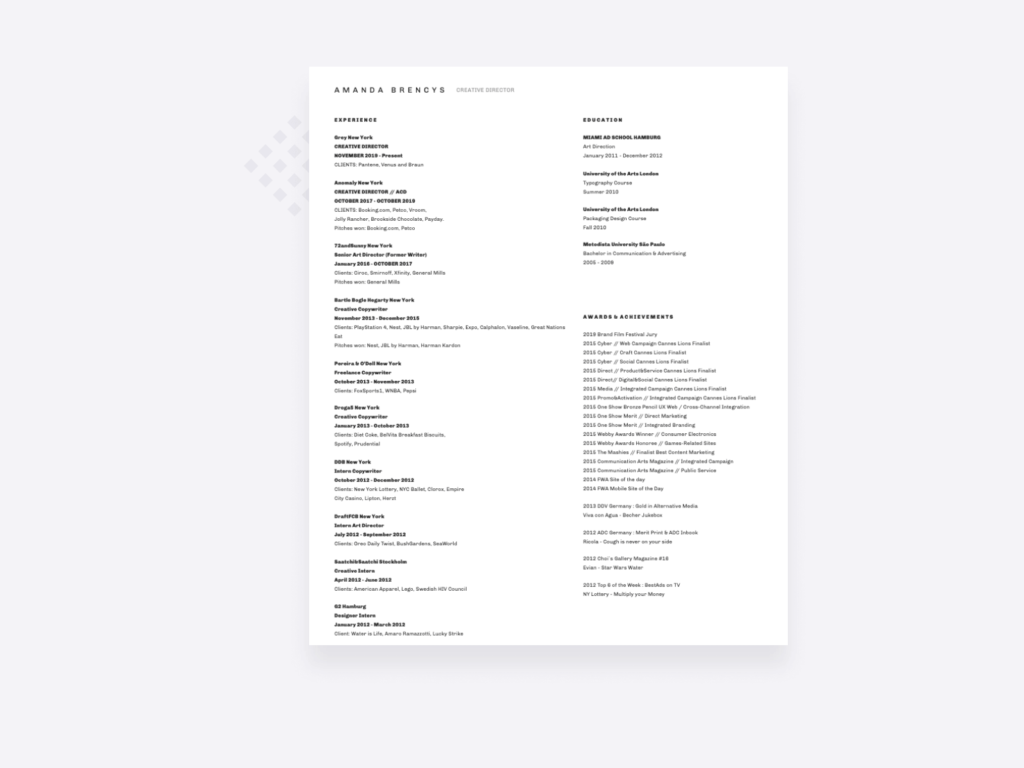
John Friedman - Senior Copywriter / 215 McCann
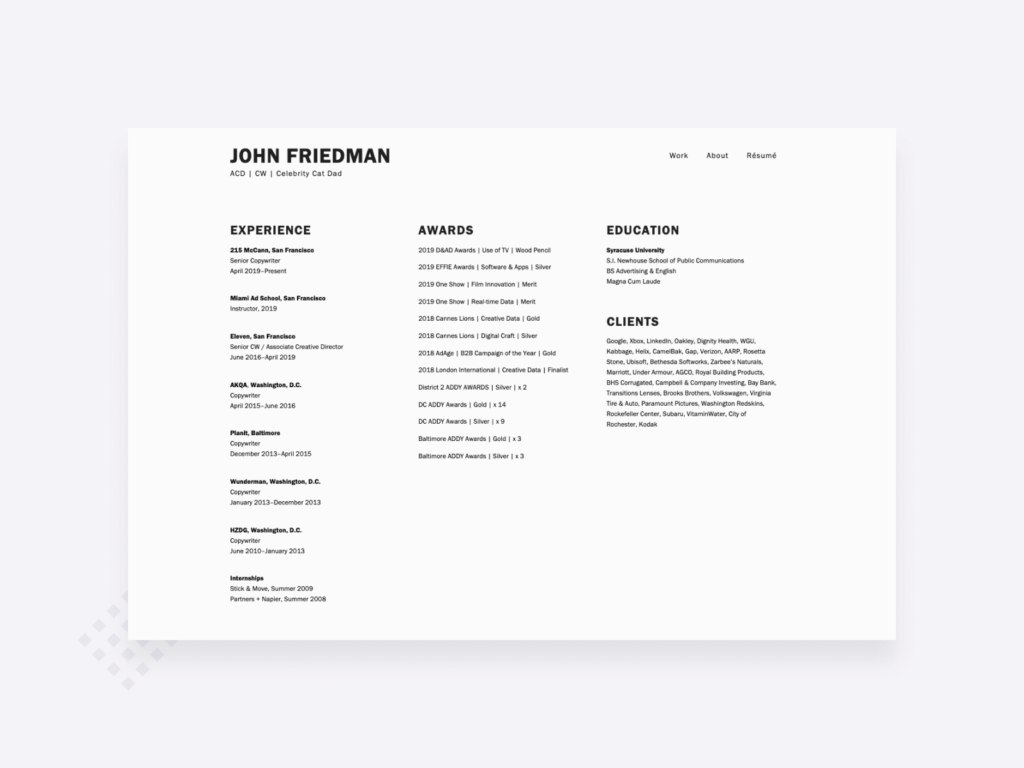
Benji Shaw - Senior Copywriter / DDB
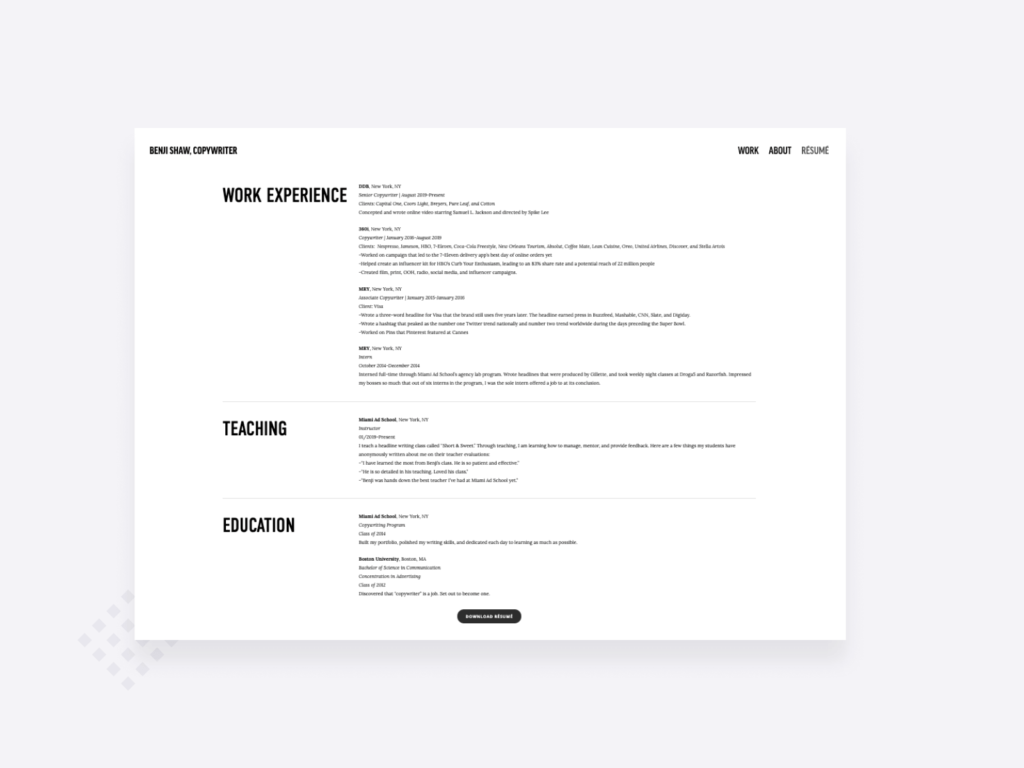
C.J Thomas - Senior Copywriter / Saatchi & Saatchi
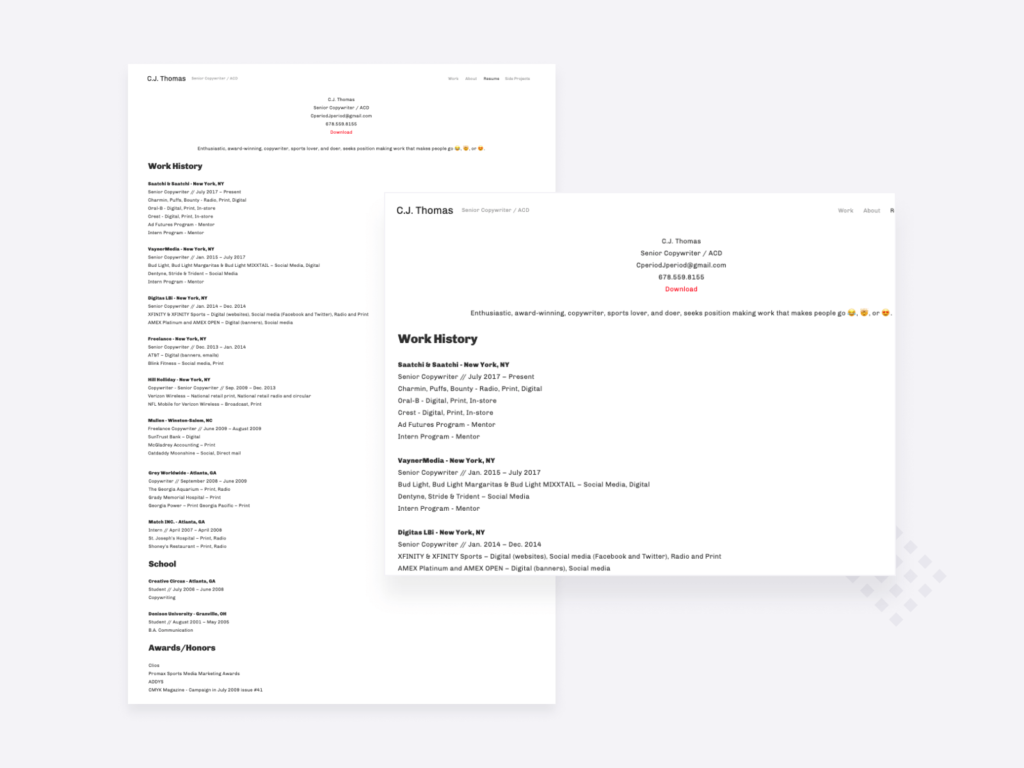
Scott Muska - Senior Copywriter / Huge
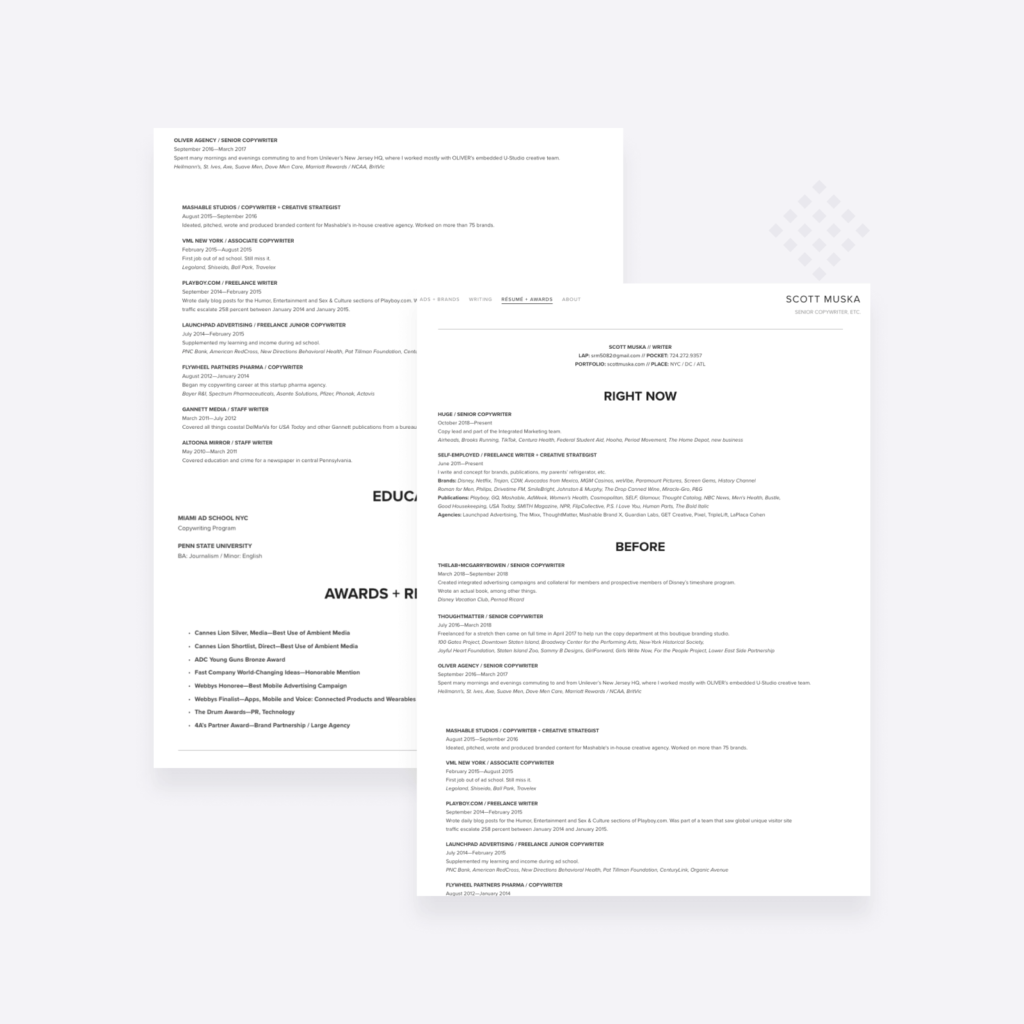
For these examples, we chose simpler designs that you can easily recreate yourself. What’s common in them is that they:
- Use a simple white background, black text and only one font. This keeps the design minimal and coherent. If you follow along, it will be hard to mess it up.
- Have very clear sections. They all use either columns, lots of white space, or big headers to separate each resume section. It makes the whole resume easy to overview and avoids the text to be overwhelming.
- Are brief but have the most important information: work experience, awards, education, and client names.
Alternatively, you can create a PDF using one of the following ways.
- The most basic method: use Microsoft Word. Especially if you don’t mind a minimalistic design, you can just open up a new document and type your information in there. Then when you’re done, save it as a PDF. There are multiple free resume templates that work with Word that can make the process even easier.
- A bit more advanced: use a design tool. Adobe InDesign in an industry-standard tool for creating publications and similar materials, so many people use it to design their resumes. Or you can choose a free alternative like Canva if you’re not comfortable with a professional software.
- The easy but costly way: hire someone. If you have all the information written down but have neither the time nor the desire to do it yourself, you can always hire a designer to do it for you. It might cost a little bit, but you can save lots of time and end up with a CV that looks amazing.
It’s worth mentioning that even if you decide to write your resume as a page on your website, some people might still expect a button to download it as a PDF. Also, if you’re applying for a job and they ask for your copywriter resume as an attachment, they might not be happy to get a link instead.
How to write a copywriter cover letter
Although in most cases your resume-portfolio combo should do the job, for some positions they specifically ask for a cover letter as well. A copywriter cover letter is not much different from any others - except that they might expect it to be entertaining and fun to read.
There are some general rules you should follow to write a convincing copywriter cover letter:
- Write a specific cover letter for each application
It goes without saying, but you should always tailor your cover letter to the job you’re applying for.
Start out by carefully reading the job description. What is their dream candidate like? Write a list of the keywords of skills and past experiences they’re looking for and reflect on them in your cover letter.
- It should be about them, not you
That sounds a bit contradictory, considering we’re talking about cover letters, right? But if you think about it... Your cover letter is so much more powerful if you talk about how their company could benefit from having you and what they could achieve with your help.
If you’re just telling them how amazing you are in general, they might feel like you’re just trying to make yourself look good. But approaching it from their perspective, you’re creating a vision for them. And if it’s written well, you can really make an impact.
- Let your motivation shine through
Of course, the whole point of the cover letter is to show them you want to work there. But sometimes it can still come out a little bland.
Do you have any personal connection to the company or their industry? Any anecdotes you can share? Include them so they see that for you it’s not “just another position”.
Convince them that being a skilled copywriter and an overall good fit is not the only reason why they should hire you. Show them that with you they will gain a determined and motivated employee that will fight for their vision with them.
- Make sure your grammar is impeccable
Another thing you probably already know, but we’ll say it anyway. Make sure your grammar, spelling, and punctuation are perfect.
Making mistakes in these regards will tell hiring managers that it’s either your English skills or your attention to detail that’s lacking. Needless to say, for a copywriter position, either of these would be a reason for immediate rejection.
Attaching your copywriter portfolio
Your copywriter resume cannot exist without a portfolio. Sure, it nicely lists the companies you worked for and the schools you studied at.
But what about your skills in practice? Your writing style? The types of copy you’re best at? And the niches you write most comfortably in? Here’s where your portfolio comes into play.
When you’re applying for a copywriter job, they will expect you to hand in a portfolio alongside your resume. And if you’re not linking to it in your application email, they will be looking for it in your CV. It’s just as necessary, if not more important, than the resume itself.
As hiring managers have a limited time to look at your CV, they also don’t have hours to spend on your portfolio. But the difference is that while they look at your resume for about 10 seconds only, they can spend 5-10 minutes looking through your portfolio.
That says a lot about the importance and where you should focus your resources, right?
What makes a good portfolio?
- Lots of visuals to catch your eye. While it’s more common for resumes to have a minimal black and white design, a good portfolio goes further than that. You should bring some color into the picture, if not with the design of the page, then with screenshots and big project thumbnails.
- Brief explanations. While the centerpiece of the portfolio is the finished copy, it’s important to include information on how it came to be. Speaking about the challenge and your problem-solving process is crucial, but you have to do it briefly. Lack of time, remember?
- Personality. Your portfolio is a great way for others to get to know you a little better. Through the projects you chose to display and how you decided to present them. With the copy you include and the about page you put together. It gives you a chance to show who’s behind all this amazing copy, so don’t miss out on it!
How to create a copywriting portfolio?
There are multiple ways to create a copywriting portfolio, but the fastest and easiest way is by using a portfolio builder tool that was designed for copywriters. One that will…
- Let you create a stunning personal website in a matter of minutes
- Require no design or coding skills to do so
- Help you with visuals so you can focus on what you’re best at, and
- Guide you through building your case studies to create a portfolio that will get you hired
If you like how that sounds, you’ll love our new tool. Copyfolio is now live, so sign up and create your copywriting portfolio today!





